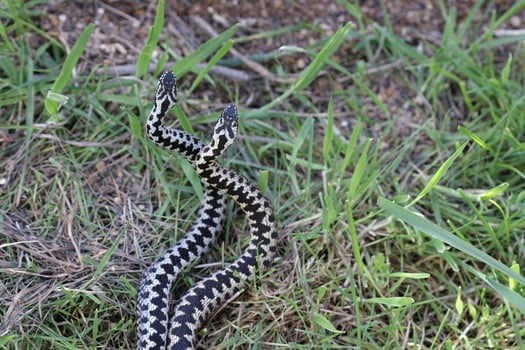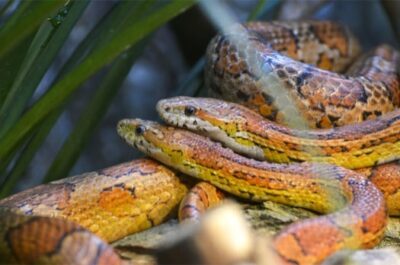Housing two snakes together means that you save on resources, minimize cleaning, and utilize space more efficiently. The problem is that snakes aren’t social animals and see each other as threats.
Putting two snakes together, such as a pair of males or two snakes of different sizes, could lead to fighting. A mixed pair (male and female) could breed. Kingsnakes should always be housed separately because they eat other snakes, even copperheads. A pair of garter snakes can be kept together in the same enclosure, but there’s a higher risk of spreading disease and infestations, such as ticks and mites.
There are situations where two snakes can live together, such as two female corn snakes. But this is only the case when certain circumstances apply and, even then, there are rules that must be followed to prevent fighting. It can also be difficult to figure out when/which snake is sick.
Is Keeping Two Snakes Together Recommended?
It’s rarely a good idea to keep a pair of snakes in the same tank. However, much depends on the species, size, temperament, and sex combination.
| Snake Species | Two Male Snakes | Two Female Snakes | Male and Female Snake |
|---|---|---|---|
| Kingsnake: | No | No | No** |
| Rosy Boa: | No | No | No** |
| Corn Snake: | No | Yes* | No** |
| Garter Snake: | Yes* | Yes* | No** |
| Ball Python: | No | No | No** |
| Two Different Species: | No | No | No** |
* Snakes that are housed together MUST be the same size and separated during feeding. Combined feeding can lead to fighting and bullying, with the larger snake eating all of the food. The smaller snake gets nothing.
** Avoid putting together a male and female snake together or they’ll breed.
Can You Put Two Kingsnakes Together?
Kingsnakes got their name because, in the wild, they eat other snakes as part of their regular diet.
Owners have woken up to find that one of their pet snakes has gone missing, not realizing that it’s been eaten overnight.
Even if you keep the two snakes well-fed, this combination isn’t recommended. Unlike other types of snakes, two kingsnakes that are roughly the same size may still attack each other.
Can You Keep Two Rosy Boas Together?
Rosy boas are known to be gentler snakes. So, is it possible to keep two rosy boas in the same tank?
Even rosies are known to cannibalize each other. At the very least, two male Rosy boas are likely to fight and be competitive as they’re hardwired to behave that way from centuries of living in the wild.
Putting a male and female Rosy boa to avoid fighting can lead to unexpected breeding. Having your female snake fall pregnant isn’t a good idea, unless you’re prepared for caring for baby snakes.
Also, a snake that goes into breeding mode can stop eating.
Can Two Corn Snakes Live Together?
It’s possible to house corn snakes together if they’re both female and roughly the same size. Female corn snakes get on reasonably well with one another. They won’t fight unless they’re completely different sizes.
If one corn is big and the other small, one corn snake will be more dominant. The bigger snake will eat the smaller snake’s food, bully it away from prime basking spots, and make the other snake’s life miserable.
Feed them separately so that they don’t fight over food. Take them out of their enclosure and feed them away from one another.
Can Garter Snakes Live Together?
Garter snakes are rare among snakes, in that they’re more ‘social’ than other species. They hibernate (brumate) together throughout the winter.
Garter snakes hide in large dens, which can be filled with literally hundreds of snakes, if not thousands, according to Penn State University.
It’s a similar story when they mate when dozens of males all compete for the attention of the female in a ‘mating ball.’
This is why garter snakes are quite comfortable when housed together. Housing them in the same tank seems to reduce stress. However, you should still house males and females separately to avoid breeding.

Can You Keep Two Ball Pythons in the Same Tank?
Ball pythons are docile with their owners, and would much rather curl up into a protective ball than try and strike you. You might think they’d get on well with other snakes in the same enclosure, but they don’t.
Ball pythons don’t display any unique social behaviors, like garter snakes. In the wild, they aestivate (conserve water and energy) by hiding in small burrows, but not with other snakes.
They don’t seek out other snakes for company, and so you aren’t doing them any favors by housing them together in captivity.
Keeping Different Breeds of Snake Together
Don’t keep different breeds of snakes together. Some snakes predate on other species. California kingsnakes eat rattlesnakes, for example.
It’s in their nature to hunt and kill other snakes of different species. Not only that, but snakes of various species grow to different sizes, and at different rates. The bigger the size difference, the more likely that one will bully or cannibalize the other.
Different species have different housing needs. A reticulated python lives in the rainforests of Southeast Asia and needs the heat and humidity it would find there. Western hognoses live in much drier environments.
Even if they were the same size at the time, in this sort of situation, you would be compromising the health of one snake over the other.
Why Can’t You Keep Snakes Together?
Keeping snakes together is a bad idea. They’re still solitary creatures, and they still have natural instincts to fight for dominance, food, and mates. We’ll now explore the different reasons why problems occur.
Fighting Between Male Snakes
Two male snakes have to compete for resources and mating rights.
- A pair of male snakes would fight over any available food. If you were to throw food into an enclosure with two males in it, they would attack each other. The winner would eat and the loser wouldn’t.
- Males will fight over breeding rights. In nature, the bigger males will fight off smaller males to get close to females that are ready to mate.
Cannibalism
Some snakes prey on other snakes as a regular part of their diet, for example, the kingsnake got its name because it kills and eats other snakes.
Also, snakes don’t control their feeding response. Once they start eating something, they can’t stop themselves.
For example, you can force a snake to eat more by pushing a prey item into its mouth while finishing the first prey item.

Spread of Diseases
Housing snakes together also increase the likelihood that diseases, infections, and parasites will spread between them.
The more contact snakes have with one another, the easier it is for them to catch a disease. Examples include ticks, mites, and worms.
Wash your hands after handling a snake. This prevents you from passing on parasites and diseases onto your snake through handling.
Feeding Issues
Keeping two or more snakes in the same enclosure can cause feeding issues. That’s because snakes naturally fight for dominance.
The dominant snake will steal the other snake’s food, even if they’re not hungry. The smaller snake will be going hungry and could starve.
If you decide to house two snakes together, take them out of the enclosure to feed them separately, in two different places. Only once you’ve fed them both should you bring them back.
Unplanned Breeding
If you house a male and a female snake together, they’re going to breed. Different snake species come of age at different times, but females are ready to mate between two and three years of age.
They have to get big enough to carry eggs and have to have enough energy stored to carry them. Males often come of age sooner than females do, and when they come of age, they’ll want to mate.
If the male mates with the female when she’s not ready, she won’t be able to give birth to the eggs. This causes ‘egg binding,’ which is where the snake tries to lay the eggs, but they’re too big for her to birth.
This can kill the female. This problem often arises because it’s a complicated process to figure out a snake’s sex (sexing). This means that you might be housing a male and female together unknowingly.
Stressful Environment
If you house two snakes together, it’ll cause stress. Ongoing competition for food, basking spots, dominance, etc is very unsettling.
One behavior that you’re sure to notice if your snakes are stressed is that they rub their face against the wall of the enclosure. Under stressful conditions, they’ll continually rub their nose until it’s raw and infected.
Snakes don’t need company, either in the wild or captivity. The general rule is that snakes should be housed separately.

